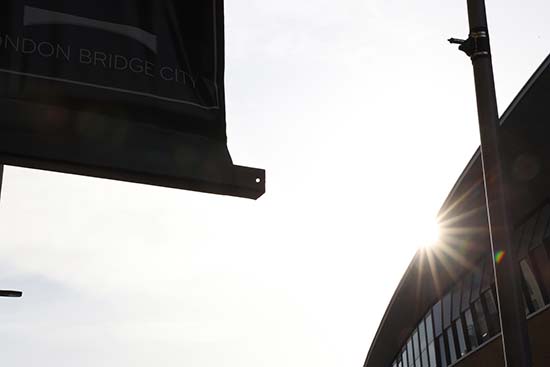Canon RF 28-70mm F2L USM
Содержание
Canon RF 28-70mm f2 L USM Sample Images
The thumbnails below link to full-sized samples taken with the Canon RF 28-70mm f/2 L USM lens mounted on a Canon EOS R camera.
|
Preview 1/500s · f/2 · ISO 100 Download Original |
Preview 1/320s · f/8 · ISO 100 Download Original |
Preview 1/250s · f/8 · ISO 100 Download Original |
|
Preview 1/400s · f/5.6 · ISO 100 Download Original |
Preview 1/1250s · f/4 · ISO 100 Download Original |
Preview 1/320s · f/4 · ISO 100 Download Original |
|
Preview 1/1250s · f/2 · ISO 100 Download Original |
Preview 1/125s · f/8 · ISO 100 Download Original |
Preview 1/125s · f/8 · ISO 100 Download Original |
|
Preview 1/80s · f/2 · ISO 200 Download Original |
Preview 1/80s · f/5.6 · ISO 500 Download Original |
Preview 1/100s · f/22 · ISO 200 Download Original |
|
Preview 1/2500s · f/2 · ISO 100 Download Original |
Preview 1/2500s · f/2 · ISO 100 Download Original |
Preview 1/125s · f/2 · ISO 100 Download Original |
|
Preview 1/80s · f/8 · ISO 100 Download Original |
Preview 1/125s · f/8 · ISO 100 Download Original |
Preview 1/80s · f/8 · ISO 320 Download Original |
|
Preview 1/400s · f/8 · ISO 100 Download Original |
Preview 1/400s · f/8 · ISO 100 Download Original |
Preview 1/250s · f/8 · ISO 100 Download Original |
|
Preview 1/80s · f/2 · ISO 320 Download Original |
Preview 1/100s · f/2 · ISO 250 Download Original |
Preview 1/5000s · f/2 · ISO 100 Download Original |
|
Preview 1/640s · f/2 · ISO 100 Download Original |
Preview 1/640s · f/2 · ISO 100 Download Original |
Preview 1/500s · f/8 · ISO 100 Download Original |
|
Preview 1/80s · f/8 · ISO 160 Download Original |
Preview 1/100s · f/5.6 · ISO 100 Download Original |
Preview 1/2500s · f/2 · ISO 100 Download Original |
|
Preview 1/1600s · f/2 · ISO 100 Download Original |
Preview 1/80s · f/11 · ISO 125 Download Original |
Preview 1/60s · f/16 · ISO 320 Download Original |
|
Preview 1/80s · f/22 · ISO 640 Download Original |
Preview 1/1600s · f/2 · ISO 100 Download Original |
Preview 1/1000s · f/5.6 · ISO 100 Download Original |
|
Preview 1/2000s · f/2 · ISO 100 Download Original |
Preview 1/500s · f/4 · ISO 100 Download Original |
Preview 1/60s · f/8 · ISO 125 Download Original |
|
Preview 1/1250s · f/2 · ISO 100 Download Original |
Preview 1/2500s · f/2 · ISO 100 Download Original |
Preview 1/80s · f/11 · ISO 125 Download Original |
|
Preview 1/3200s · f/2 · ISO 100 Download Original |
Preview 1/800s · f/4 · ISO 100 Download Original |
Preview 1/250s · f/5.6 · ISO 100 Download Original |
|
Preview 1/80s · f/4 · ISO 500 Download Original |
Previous Page
« Sharpness: 4
Next Page
Lens Specs »
- Ease of Use
- Sharpness: 28mm
-
35mm
-
50mm
-
70mm
- Sample Images
- Lens Specs
- Rating & Conclusion
- Main Rivals
- Review Roundup
- Ease of Use
- Sharpness: 28mm
-
35mm
-
50mm
-
70mm
- Sample Images
- Lens Specs
- Rating & Conclusion
- Main Rivals
- Review Roundup
Conclusion
There’s no getting away from the fact that the new Canon RF 28-70mm f/2 L USM lens is very big, heavy and expensive, but there’s also no getting away from the fact that it’s extremely well-built, fast in terms of the maximum aperture, and capable of delivering superlative image quality.
We’ve seen the Canon RF 28-70mm f/2 L USM described as offering four prime lenses in one, and after using it for an extended period of time, we’d certainly agree with that assessment. Whether using it as 28mm, 35mm, 50mm or 70mm, it delivers tack-sharp images both in the centre and at the edges of the frame, with no need to stop down to get acceptable results. That means that you can shoot at f/2 at any focal length and get buttery-smooth bokeh as a result of the 9-blade aperture and that maximum aperture that is one-stop faster than most zooms of this type. Slight vignetting at wide-open apertures and a little barrel distortion at 28mm are the only real optical issues of note from what is optically an incredible lenses.
Of course, combining four quality lenses into one inevitably makes this single lens very big and heavy — there’s no getting away from the fact that using the Canon RF 28-70mm f/2 L USM for extended periods of time can prove tiring. It also feels a little unbalanced and front heavy on the EOS R camera, which is currently the biggest, most pro-level body that Canon currently offer. The Canon RF 28-70mm f/2 L USM would certainly be more at home on a larger camera body than the EOS R.
Build quality is excellent, certainly up to the usual L-lens standard, with the built-in weather-proofing offering peace of mind in more inclement conditions. Given the price, though, we’d have liked to have seen a better case included in the box, rather than the standard soft pouch.
Auto-focusing was quick, quiet and reliable on the Canon EOS R camera body that we tested the lens with, while manual focus over-ride at any time is a great feature. The new Lens Control Ring takes a little getting used to, but soon becomes quite a handy feature to have. We did miss having any form of image stabilisation when using this lens with the EOS R in low-light, as neither this lens or particular camera body offer it.
Ultimately whether you think the asking price of £3079.99 / $2999.99 for this lens is acceptable or not comes down to how you intend to use it and how many other lenses it could effectively replace in your kit. Pro photographers looking for the ultimate in speed and image quality need look no further. More casual shooters who primarily value portability and cost should look at the RF 24-105mm f/4, which is an excellent lens in its own right. But if you want to be blown away by what Canon are capable of delivering via their new EOS R full-frame system, then look no further than the incredible Canon RF 28-70mm f/2 L USM lens.

| Ratings (out of 5) | |
|---|---|
| Design | 4.5 |
| Features | 4.5 |
| Ease-of-use | 4 |
| Image quality | 5 |
| Value for money | 4 |
Previous Page
« Lens Specs
Next Page
Main Rivals »
- Ease of Use
- Sharpness: 28mm
-
35mm
-
50mm
-
70mm
- Sample Images
- Lens Specs
- Rating & Conclusion
- Main Rivals
- Review Roundup
- Ease of Use
- Sharpness: 28mm
-
35mm
-
50mm
-
70mm
- Sample Images
- Lens Specs
- Rating & Conclusion
- Main Rivals
- Review Roundup
Canon RF 28-70mm f2 L USM Introduction
The RF 24-70mm f/4L IS USM is designed to be the ultimate standard zoom lens for Canon’s full-frame mirrorless camera system. This lens offers the versatility of a zoom combined with the fast maximum aperture of a quality prime — it’s the only standard zoom lens that we’ve ever reviewed with a maximum f/2 aperture.
Comprised of 19 elements in 13 groups, including four aspherical elements, a pair of Ultra Low Dispersion (UD) elements and a Super UD element, the RF 28-70mm f/2 also features an Ultrasonic Motor for quick and quiet auto-focusing, fluorine coatings on the front and rear lens elements, SWC and ASC coatings to help reduce ghosting and flare, 9 rounded diaphragm blades for smoother bokeh, a zoom lock switch to prevent lens creep, and weather-resistant construction.
The new Canon RF 28-70mm f/2 L USM officially retails for £3079.99 / $2999.99 in the UK and the USA respectively.
Ease of Use
The Canon RF 28-70mm f/2 L USM is a large and very heavy lens, considering the rather modest focal range that it covers, weighing in at a whopping 1430g and measuring 14cm in length, extending further to 16cm when the lens is set to 70mm. It’s best to think of this lens as four high-quality prime lenses in one, rather than just as a standard zoom, in which case it makes more sense from a size point of view.
Build quality is superb. The Canon RF 28-70mm f/2 L USM feels like a tank in your hand, even if the exterior is mostly made out of plastic, and it features enhanced resistance to shock and vibration and weather-proofing too.
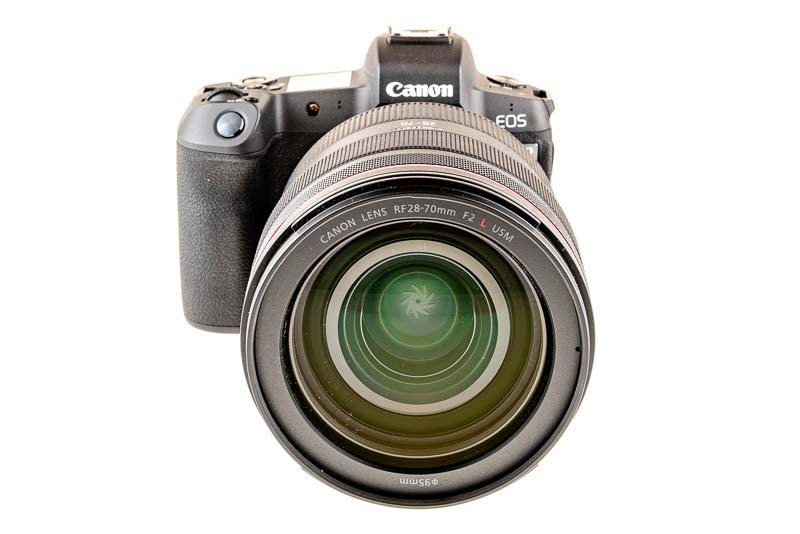

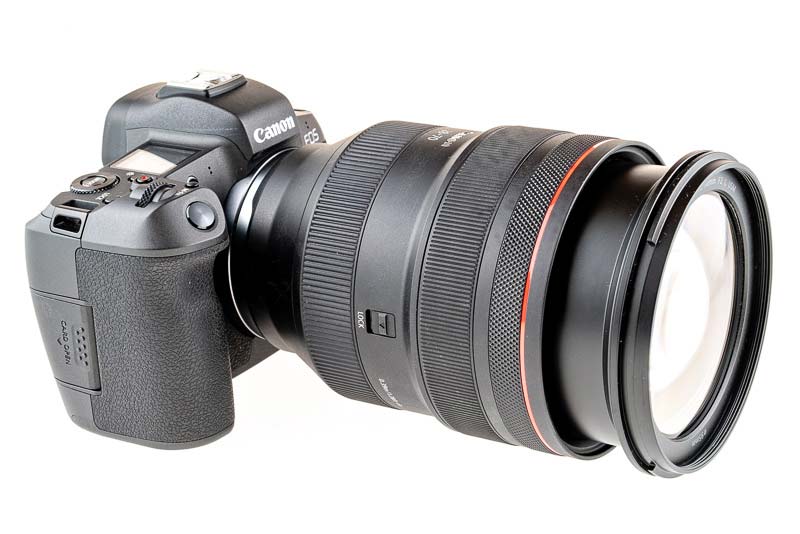
A new feature for RF lenses is the Lens Control Ring at the end of the lens barrel, which can be used to control certain key camera settings. Although not a new concept in the wider photography world, this is the first time that Canon have incorporated this idea into their interchangeable lenses. You can use this to change a variety of settings including aperture, shutter speed, ISO and exposure compensation.
The Canon RF 28-70mm f/2 L USM does not feature Image Stabilisation, instead relying on its fast aperture of f/2 top help when shooting in low-light. It’s worth noting that virtually all other top-of-the-range zoom lenses typically offer a maximum aperture of f/2.8, a whole stop slower than the RF 28-70mm f/2 L USM, which is one of the principal reasons for the size and weight of this lens.
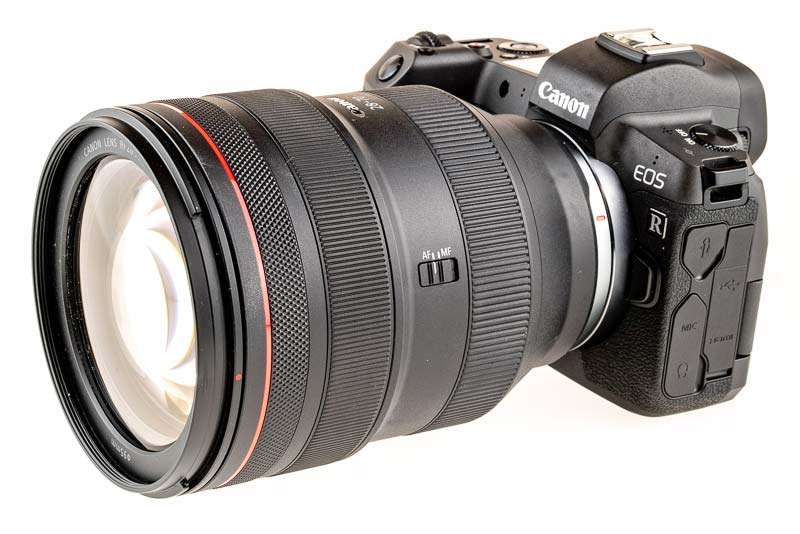


The Lock function switch is a useful feature that helps protect the Canon RF 28-70mm f/2 L USM lens. Set the focal length to 28mm and move it to the Lock position to prevent the zoom mechanism from creeping when the camera is pointed down or in storage.
The final control on the lens barrel is a focus mode switch with the usual AF/MF settings. Note that this lens usefully offers full-time manual focusing even when AF is selected.
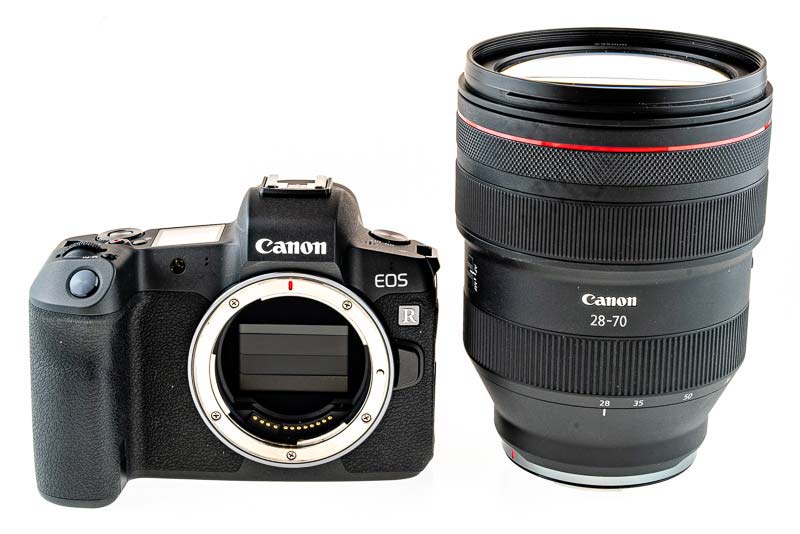
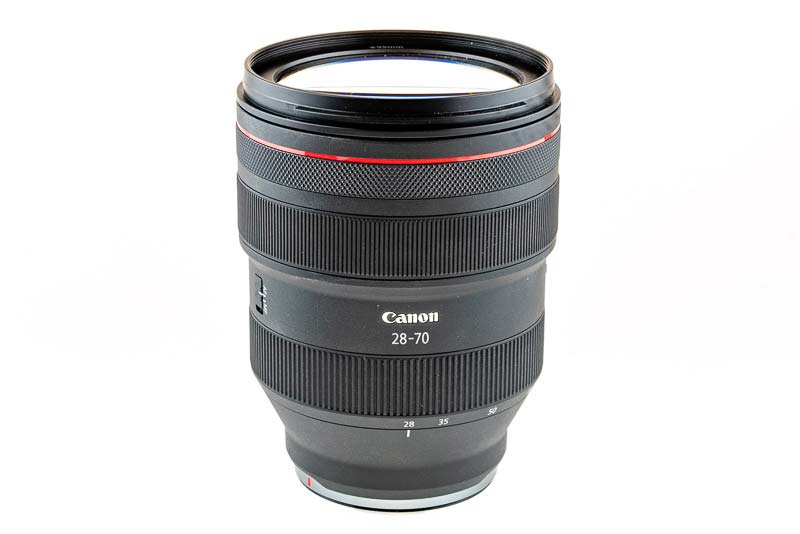
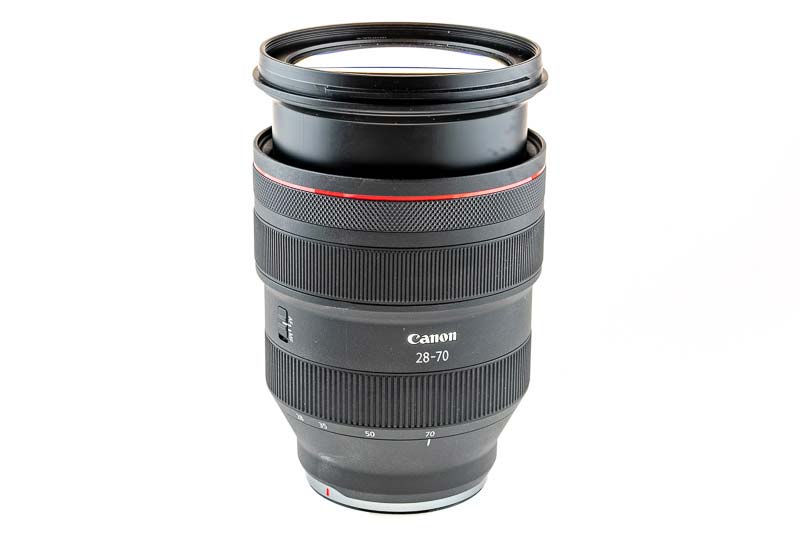
The focusing ring is wide enough to find easily, and it has a ridged, rubberised grip band. There are no hard stops at either end of the range, making it more difficult to set focus at infinity. Polariser users should be pleased that the huge 95mm filter thread doesn’t rotate on focus.
When it comes to auto-focusing, the Canon RF 28-70mm f/2 L USM zoom is a very quick performer, taking around 0.10 seconds to lock onto the subject when mounted on the Canon EOS R camera that we tested it with.
We didn’t experience very much «hunting» at all, either in good or bad light, with the lens accurately focusing virtually all of the time. It’s also a pretty quiet performer, thanks to the built-in USM (Ultra Sonic Motor).
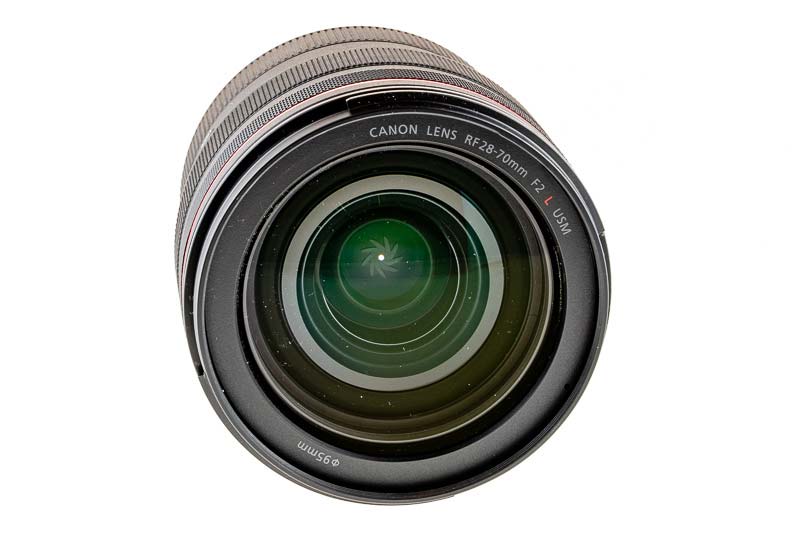

The Canon RF 28-70mm f/2 L USM lens ships with a plastic, petal-shaped lens hood (EW-103E) and a soft drawstring pouch (LP1424). Given the asking price, we’d have liked to have a better case included.
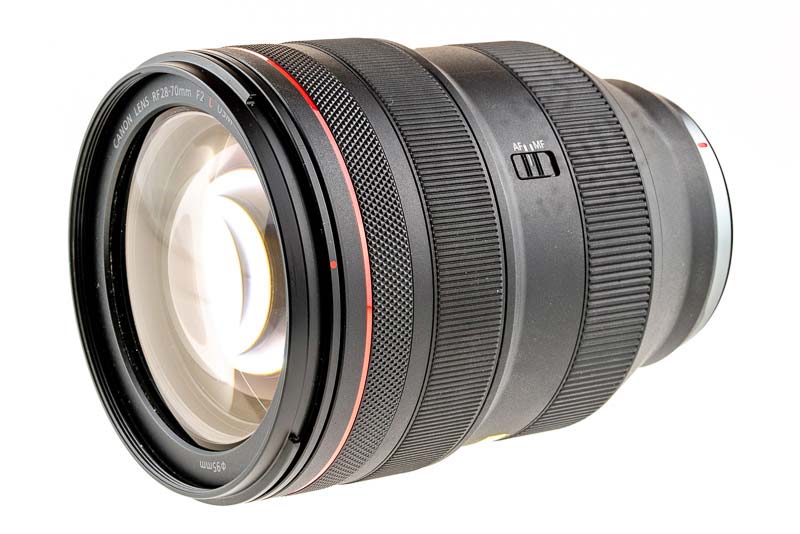
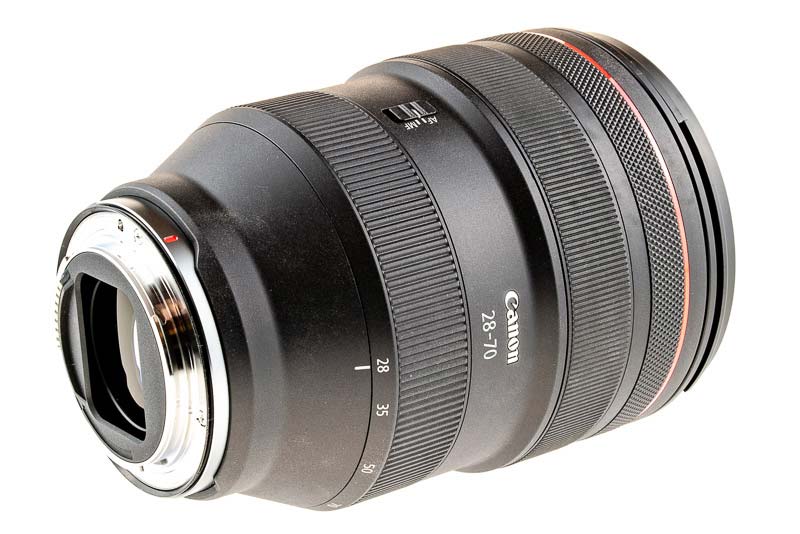

Focal Range
At the 28mm focal length the angle of view is 65 degrees.
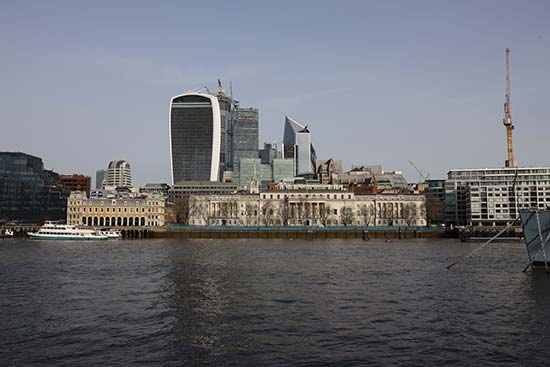 28mm
28mm
At the 70mm focal length the angle of view is 29 degrees.
 70mm
70mm
Chromatic Aberrations
Chromatic aberrations, typically seen as purple or blue fringes along contrasty edges, are very well controlled with the Canon RF 28-70mm f/2 L USM — so much so that we couldn’t find any examples at all in our test shots.
Light Fall-off
With the Canon RF 28-70mm f/2 L USM lens wide open, you can only see a little light fall-off in the corners at both ends of the zoom range. Stopping down helps, although to completely get rid of this phenomenon, you will need to use an f-stop of f/4 or smaller.
Barrel distortion is slightly evident at the 28mm wide-angle focal length, but it disappears completely by 35mm.
 28mm
28mm
 70mm
70mm
Macro
The Canon RF 28-70mm f/2 L USM is not a macro lens. The close-focus point is at 39cm from the film/sensor plane, and Canon quotes a maximum reproduction ratio of 0.18x for the lens when set to 70mm. The following example illustrates how close you can get to the subject.

Sunstars
The Canon RF 28-70mm f/2 L USM produces fairly nice sunstars when stopped-down to f/16 or f/22, although be careful to watch out for flare effects when shooting directly into the sun.
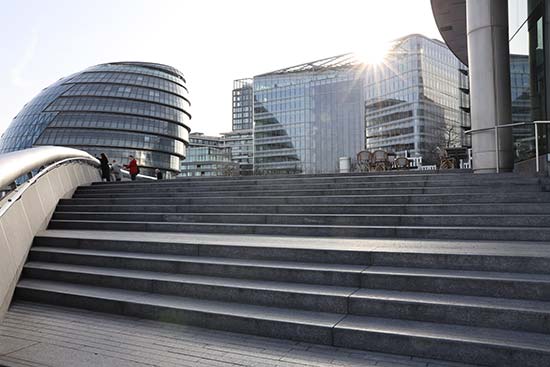
Bokeh
Bokeh is a word used for the out-of-focus areas of a photograph, and is usually described in qualitative terms, such as smooth / creamy / harsh etc. Canon have employed an iris diaphragm with nine rounded blades for a pleasing rendering of the out-of-focus highlights. Based on what we have seen, we can say that they have largely succeeded. Below you’ll find some examples, but you are also encouraged to check out our sample images.





Sharpness
In order to show you how sharp the Canon RF 28-70mm f/2 L USM lens is, we are providing 100% crops on the following pages.
- Ease of Use
- Sharpness: 28mm
-
35mm
-
50mm
-
70mm
- Sample Images
- Lens Specs
- Rating & Conclusion
- Main Rivals
- Review Roundup
- Ease of Use
- Sharpness: 28mm
-
35mm
-
50mm
-
70mm
- Sample Images
- Lens Specs
- Rating & Conclusion
- Main Rivals
- Review Roundup
Canon RF 28-70mm f2 L USM Main Rivals
Listed below are some of the rivals of the Canon RF 28-70mm f/2 L USM.
Canon EF 24-70mm f/2.8L II USM
The Canon EF 24-70mm f/2.8L II USM is a professional standard zoom lens for full-frame DSLR cameras. Officially retailing for a whopping £2299.99 / $2299.99, does the Canon 24-700mm f/2.8 offer good enough image quality to justify its price-tag? Read our in-depth Canon EF 24-70mm f/4L IS USM review, complete with full-size sample images, to find out…
Canon RF 24-105mm f/4L IS USM
The Canon RF 24-105mm f/4L IS USM is the standard kit lens for the new Canon EOS R full frame mirrorless camera, but is it any good? Find out if you should buy one to go with your EOS R by reading our in-depth Canon RF 24-105mm f/4L IS USM review…
Canon RF 35mm f/1.8 IS Macro STM
The Canon RF 35mm f/1.8 IS Macro STM is a classic 35mm prime for the new Canon EOS R full frame mirrorless camera that also usefully doubles up as a macro lens. Read our in-depth Canon RF 35mm f/1.8 IS Macro STM review to find out if this attractively priced lens is worth considering…
Canon RF 50mm f/1.2L USM
The Canon RF 50mm f/1.2L USM is an amazingly fast, amazingly expensive 50mm prime lens for the new Canon EOS R full frame mirrorless camera system. Read our in-depth Canon RF 50mm f/1.2L USM review to find out if this ultra-fast lens can really be worth £2349 / $2299…
Sigma 24mm F1.4 DG HSM
The Sigma 24mm F1.4 DG HSM is a fast wide-angle prime lens for full-frame DSLR cameras. Retailing for £799 / $849, read our expert Sigma 24mm F1.4 DG HSM review to find out if it’s as good as the 35mm and 50mm Art lenses…
Sigma 35mm F1.4 DG HSM
The Sigma 35mm F1.4 DG HSM is a moderate wide-angle lens in the full-frame format, or a fast standard prime when mounted on an APS-C body. The 35mm f/1.4 features 13 optical elements in seven groups with one aspherical lens element and a HSM focusing system which provides quiet, smooth and fast autofocus with full-time manual focus override. Retailing for £799 / $899, read our expert Sigma 35mm F1.4 DG HSM review to find out if it’s a worthy alternative to the Canon, Nikon and Sony equivalents.
Sigma 50mm F1.4 DG HSM
The Sigma 50mm F1.4 DG HSM is a fast standard prime lens for full-frame DSLR cameras. The 50mm f/1.4 features 13 optical elements in 8 groups and a HSM focusing system which provides quiet, smooth and fast autofocus with full-time manual focus override. Retailing for £859 / $949, read our expert Sigma 50mm F1.4 DG HSM review to find out if it’s the ultimate «fast fifty» lens…
Tamron 28-75mm F2.8 Di III RXD
The Tamron 28-75mm F2.8 Di III RXD is the first non-Sony standard zoom lens for the popular Alpha series of full-frame mirrorless cameras. Is this the perfect partner to the likes of the popular Sony A7 III camera? Find out now by reading our Tamron 28-75mm F2.8 Di III RXD review…
Tamron SP 24-70mm F/2.8 Di VC USD G2
The Tamron SP 24-70mm F/2.8 Di VC USD G2 is a fast standard zoom lens for Nikon and Canon full-frame DSLR shooters. Crucially offering built-in image stabilisation worth up to a claimed 5 stops of shutter speed, the Tamron 24-70mm is also weather-sealed and cheaper than the Big Two. Read our Tamron SP 24-70mm F/2.8 Di VC USD G2 review to find out if it’s the best standard zoom for full-frame users.
Previous Page
« Rating & Conclusion
Next Page
Review Roundup »
- Ease of Use
- Sharpness: 28mm
-
35mm
-
50mm
-
70mm
- Sample Images
- Lens Specs
- Rating & Conclusion
- Main Rivals
- Review Roundup
- Ease of Use
- Sharpness: 28mm
-
35mm
-
50mm
-
70mm
- Sample Images
- Lens Specs
- Rating & Conclusion
- Main Rivals
- Review Roundup
